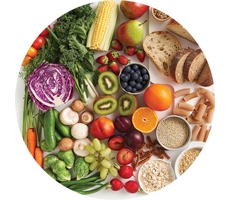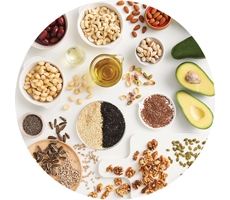
How to follow a heart healthy eating pattern
Key takeaways
- Following our 5 step heart-healthy eating pattern can help protect your heart and reduce your risk of heart disease.
- Healthy eating isn’t about “good” and “bad” foods or restrictive diets. It’s about making small changes that you can continue long term.
- Use our recipes, dinner plans, and resources to easily include heart healthy foods.
What does a heart-healthy eating pattern look like?
Our heart-healthy eating pattern is based on a combination of foods, chosen regularly, over time. It includes a wide variety of foods, is rich in wholegrains, fibre, vitamins, minerals and healthy fats, and naturally low in unhealthy fats, salt and added sugar. Eating this way can help improve heart health and lower your risk of developing heart disease by reducing risks like high blood pressure and high cholesterol.
Small changes can make a big impact. Follow our 5 step heart-healthy eating pattern to help you achieve this balance:

1. Eat plenty of vegetables, fruit and wholegrains
Choose a variety of fruit and vegetables. These foods contain lots of vitamins and minerals, fibre and antioxidants, and have been shown to reduce heart disease risk. Wholegrain foods like brown rice, wholemeal pasta, grainy bread and oats, are high in fibre and can help lower your cholesterol.

2. Include a variety of healthy protein-rich foods
The best options are plant-based proteins like legumes, nuts and seeds, as well as fish and seafood. Include smaller amounts of eggs and lean poultry and limit lean red meat to 1-3 times a week. Read more about why some proteins are better than others and how much and how often you should be including them in your eating pattern.

3. Choose unflavoured milk, yoghurt and cheese
These foods don’t increase or decrease your risk of heart disease, but can be an important source of calcium, protein, and other minerals. Unflavoured varieties with no added sugar are the healthiest options. If you have heart disease or high cholesterol, choose reduced-fat varieties. For those who don’t, you can choose between reduced-fat or full-fat options. Read about the different types of dairy foods and their impact on heart health.

4. Include healthy fats and oils
Choose foods with high amounts of healthy fats like avocados, olives, nuts and seeds, and use healthy oils for cooking, like olive, canola, sunflower, peanut and soybean oil. These foods can help lower your cholesterol. If you eat fish, try to have it 2-3 times a week to benefit from heart-healthy omega-3 fats, which help lower triglycerides in the blood and reduce the risk of irregular heartbeats.

5. Use herbs and spices to flavour foods instead of salt
Eating too much salt can lead to high blood pressure, which is a risk factor for heart disease. On average, Australians eat nearly double the recommended maximum of five grams of salt each day [5], mainly from processed and packaged foods like canned foods, deli meats and baked goods. The easiest way to reduce salt is to choose fresh, unprocessed foods like fruits and vegetables, and flavour meals with herbs and spices. Reading food labels can help you make healthier choices when choosing packaged foods. Read more about salt and your heart health.
Key information for people living with heart disease
When living with heart disease, keeping your heart healthy is important to avoid further problems. Discover key information on heart-healthy eating for people living with heart disease.
Frequently asked questions
I have heart disease/risk factors like high blood pressure or high blood cholesterol, do I need to make further changes?
Yes, there are some key changes you can make. Read our heart healthy eating information for people living with heart disease.
Does portion size matter?
We encourage you to embrace balance eating by enjoying a variety of foods, and paying attention to how much you eat.
To help get a balance of foods and nutrients in your meals, aim to:
- Fill half of your plate with vegetables or salad,
- A quarter of your plate with protein foods (about the size of the palm of your hand), and
- A quarter of your plate with carbohydrate foods like potatoes, corn and wholegrains (such as brown rice, wholemeal pasta, grainy bread and oats).
- Don’t forget to include healthy fats too.
Our Heart Foundation recipes support you to prepare heart healthy, balanced meals. Explore our full range of recipes for delicious, budget-friendly, and easy-to-prepare meals at home.
What foods should I have less of?
Healthy eating isn’t about “good” and “bad” foods or restrictive diets. It’s about making small changes that you can continue long term.
For example, reducing the amount of highly processed, or ultra-processed, food you eat is great for your heart. Up to 40 per cent[6] of the average Australian diet is currently made up of ultra-processed foods, such as:
- Baked goods e.g. cakes, biscuits and pastries
- Chocolate
- Chips
- Lollies
- Sugary drinks e.g. soft drinks, energy drinks, sports drinks
- Take away food e.g. pizza, burgers.
These foods are usually high in added sugar, salt, and saturated and trans fats, and they aren’t part of a heart healthy eating pattern. Try to have these foods only sometimes and in small amounts.
What drinks can I enjoy?
Water is the drink of choice for heart health. If you are looking for a heart-healthy drink other than water (either for flavour or for enjoyment), you can opt for the following drinks:
- Sparkling water (try adding chopped fruit or herbs; for example, fresh mint).
- Unflavoured milk.
- Plant-based milks with added calcium, like soy, almond, oat, rice milk.
- Tea.
- Coffee
- Small glass (125ml) of 100% fruit or vegetable juice.
Sugary drinks are not recommended, and we don’t recommend drinking alcohol for heart health. Read more information about the best (and worst) drinks for heart health.
Can eggs be included in a heart healthy eating pattern?
Eggs can be eaten as part of a Heart Healthy Eating Pattern. They are a good source of protein, and rich in essential vitamins and minerals such as vitamins A, E and B12, selenium, choline, and iron.
Eggs also contain cholesterol, but this type of cholesterol doesn't raise your blood cholesterol as much as foods high in saturated and trans fats do.
Most people don’t need to limit how many eggs they eat. However, if you have heart disease, high bad cholesterol (LDL), or type 2 diabetes, eating no more than 7 eggs a week is recommended.
Read more information about eggs and heart health.
I’ve heard I shouldn’t eat processed foods, is this true?
You don’t need to avoid all processed foods, but it’s important to understand the difference between “processed” and “ultra-processed” foods.
Foods can be placed into four categories based on how much they have been processed during their production[7]:
- Unprocessed or minimally processed foods: These are foods like fruits, vegetables, milk, fish, eggs, nuts, and seeds that are very close to their natural state and have no added ingredients.
- Processed ingredients: These include things like salt, sugar, vinegar, and oils, which are added to other foods.
- Processed foods: These are made by combining unprocessed foods and processed ingredients in ways similar to home cooking. Examples are jam, pickles, tinned fruit and vegetables, freshly made breads, plain yogurt, and cheeses.
- Ultra-processed foods: These have many ingredients not usually found in a home kitchen, like preservatives, sweeteners, and artificial colours. Examples are sausages, ice cream, biscuits, chips, soft drinks, mass-produced bread, some breakfast cereals, fast-foods, and ready-to-eat meals.
Some processed foods, like tinned fruits and vegetables or wholemeal bread, can be an important part of a heart healthy eating pattern. However, it’s best to eat less ultra-processed foods because they often contain unhealthy saturated and trans fats, added sugar, and salt. Research has shown that some ultra-processed foods may increase the risk of heart disease. To support your food choices, checking the Nutrition Information Panel on packaged foods can be helpful.
For more tips, check out our Reading Food Labels page.
Looking for more information on the science behind our recommendations?
We understand there is a lot of nutrition misinformation, and it’s important to find information from credible and trustworthy places. The Heart Foundation’s Heart Healthy Eating Pattern recommendations, and associated resources, are backed by the latest science and made with the unique needs of Australians in mind.
Curious about the evidence that informs our recommendations? Read more about our evidence reviews and position statements.
Healthy eating tools and resources
We're here to help! We have plenty of resources to help you follow a heart-healthy eating pattern.
- Build your skills and confidence in the kitchen with our tips and tools for planning, shopping, and cooking healthy meals!
- Explore our full range of recipes for delicious, budget-friendly and easy to prepare heart-healthy meals you can make at home.
- Discover our collection of free recipe e-books, from ‘Family recipes on a budget’ to '5 Ingredient Recipes' plus many more.
- Get four weeks of easy-to-follow dinner recipes, shopping lists, tips and other helpful information to make healthy eating easy with our free Heart-Healthy Dinner Plan.
Looking for more information? Explore our resources on healthy eating and recent articles.
References
- Institute for Health Metrics and Evaluation 2018, Global Burden of Disease Study 2017 (GBD 2017) Results, Global Burden of Disease Collaborative Network, Seattle, Available from http://ghdx.healthdata.org/gbdresults-tool Collins CE, Burrows TL, Rollo ME.
- Aune D, Giovannucci E, Boffetta P, et al. Fruit and vegetable intake and the risk of cardiovascular disease, total cancer and all-cause mortality-a systematic review and dose-response meta-analysis of prospective studies. Int J Epidemiol. 2017;46(3):1029-1056. doi:10.1093/ije/dyw319
- Dietary Patterns and Cardiovascular Disease Outcomes: an Evidence Check rapid review brokered by the Sax Institute for the National Heart Foundation of Australia, 2017 Ndanuko et al (2019)
- Animal sourced proteins (meat and poultry) and Cardiovascular Health: an evidence check brokered by the Sax Institute for the National Heart Foundation of Australia. 2019. Santos JA, Webster J, Land MA, Flood V, Chalmers J, Woodward M, Neal B, Petersen KS.
- Dietary salt intake in the Australian population. Public Health Nutrition. 2017 May:1-8. Australian Institute of Health and Welfare 2018.
- Machado PP, Steele EM, Levy RB, et al. Ultra-processed foods and recommended intake levels of nutrients linked to non-communicable diseases in Australia: evidence from a nationally representative cross-sectional study. BMJ Open. 2019;9(8):e029544. doi:10.1136/bmjopen-2019-029544
- Monteiro CA, Cannon G, Levy RB, et al. Ultra-processed foods: what they are and how to identify them. Public Health Nutr. 2019;22(5):936-941. doi:10.1017/s1368980018003762
Last updated10 January 2025
Last reviewed19 November 2024